The Intel Skylake-X Review: Core i9 7900X, i7 7820X and i7 7800X Tested
by Ian Cutress on June 19, 2017 9:01 AM ESTBenchmarking Performance: CPU Rendering Tests
Rendering tests are a long-time favorite of reviewers and benchmarkers, as the code used by rendering packages is usually highly optimized to squeeze every little bit of performance out. Sometimes rendering programs end up being heavily memory dependent as well - when you have that many threads flying about with a ton of data, having low latency memory can be key to everything. Here we take a few of the usual rendering packages under Windows 10, as well as a few new interesting benchmarks.
Corona 1.3
Corona is a standalone package designed to assist software like 3ds Max and Maya with photorealism via ray tracing. It's simple - shoot rays, get pixels. OK, it's more complicated than that, but the benchmark renders a fixed scene six times and offers results in terms of time and rays per second. The official benchmark tables list user submitted results in terms of time, however I feel rays per second is a better metric (in general, scores where higher is better seem to be easier to explain anyway). Corona likes to pile on the threads, so the results end up being very staggered based on thread count.
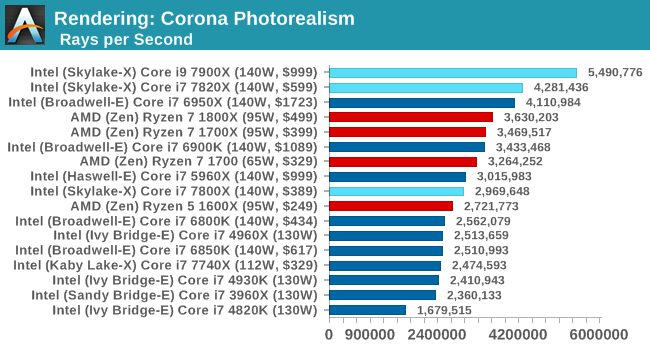
Blender 2.78
For a render that has been around for what seems like ages, Blender is still a highly popular tool. We managed to wrap up a standard workload into the February 5 nightly build of Blender and measure the time it takes to render the first frame of the scene. Being one of the bigger open source tools out there, it means both AMD and Intel work actively to help improve the codebase, for better or for worse on their own/each other's microarchitecture.
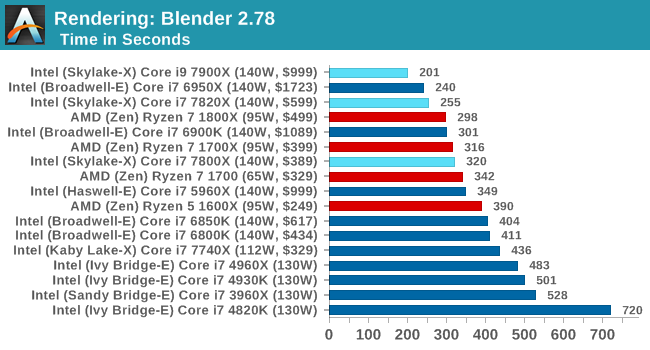
LuxMark
As a synthetic, LuxMark might come across as somewhat arbitrary as a renderer, given that it's mainly used to test GPUs, but it does offer both an OpenCL and a standard C++ mode. In this instance, aside from seeing the comparison in each coding mode for cores and IPC, we also get to see the difference in performance moving from a C++ based code-stack to an OpenCL one with a CPU as the main host.
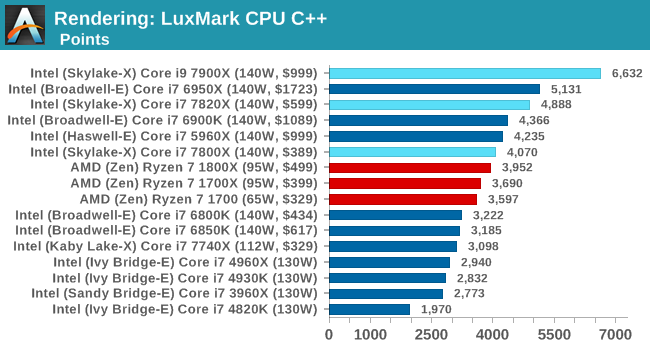
POV-Ray 3.7b3
Another regular benchmark in most suites, POV-Ray is another ray-tracer but has been around for many years. It just so happens that during the run up to AMD's Ryzen launch, the code base started to get active again with developers making changes to the code and pushing out updates. Our version and benchmarking started just before that was happening, but given time we will see where the POV-Ray code ends up and adjust in due course.
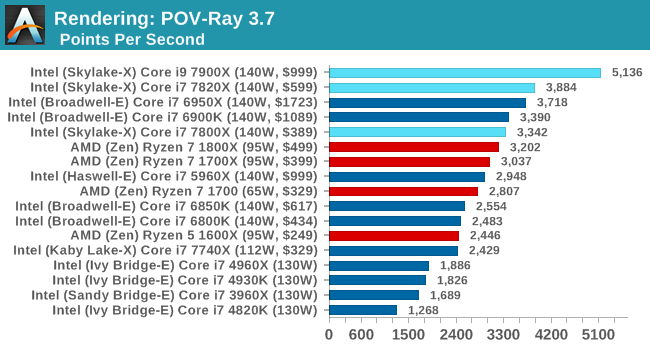
Cinebench R15
The latest version of CineBench has also become one of those 'used everywhere' benchmarks, particularly as an indicator of single thread performance. High IPC and high frequency gives performance in ST, whereas having good scaling and many cores is where the MT test wins out.
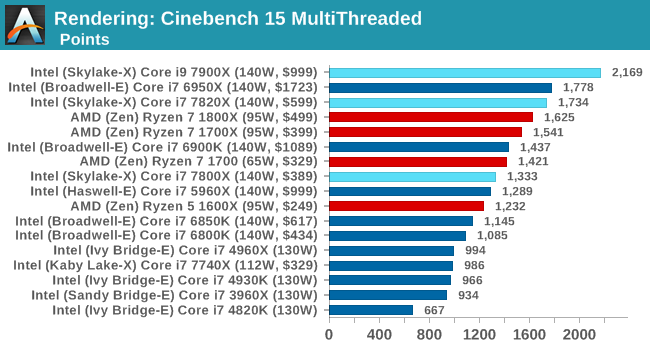
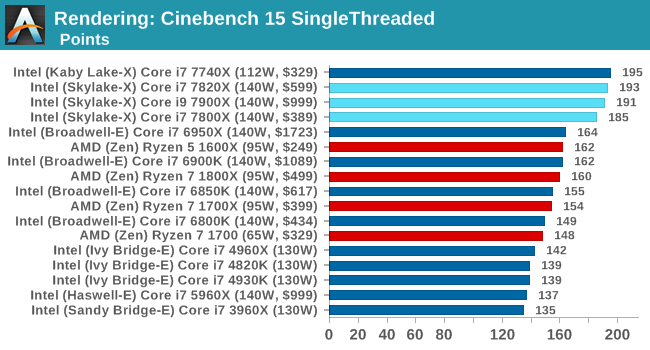










264 Comments
View All Comments
slickr - Tuesday, July 4, 2017 - link
I've been a long time user here and I can SAFELY say you got paid by Intel. How much did they pay you for this ridiculous review?nevcairiel - Monday, June 19, 2017 - link
The Ryzen 7 launch review didn't have gaming benchmarks either.ddriver - Monday, June 19, 2017 - link
That's true, my bad, I didn't remember AT's review in particular, but I remember in most reviews gaming was like 3/4 of the review...Spunjji - Tuesday, June 20, 2017 - link
My thoughts exactly. Not bagging on AT specifically here, just review sites in general. A lot of them are giving out TBD on gaming performance with mentions of it being OK at 4K, whereas with Ryzen it was all "but it games badly at 1080p which people spending $500 on a processor will totally be aiming at".bongey - Wednesday, August 2, 2017 - link
They said it in their conclusion "Gaming Performance, particularly towards 240 Hz gaming, is being questioned,""workstation cpu"
ash9 - Monday, June 19, 2017 - link
Totally agree,I find it disingenuous by this site and many others that there's an INTENTIONAL over look to the fact that the 7900X runs 70W higher (PC Perspective) than the 6950X at load- any blind man could see Intel boosted the clocks on the 7900X for cosmetic benchmark wins and to make this lineup today look relevant. Take the 7900X out of the benches and the lineup today looks anemic. This is the BS that should not go unnoticed
Alexvrb - Monday, June 19, 2017 - link
Reminds me a bit of the pre-Conroe era. Maybe they should have revived the Extreme Edition name...sweetca - Tuesday, June 20, 2017 - link
Some people actually read the reviews here because they are gathering information for an imminent decision.Not everyone wants to wait 3 weeks (maybe delays?), and then to play it safe wait another 3 weeks for the next thing, etc.
I don't post often, but I was surprised how quickly the writer's integrity and honesty were attacked, considering they were making a subjective evaluation; "safe." I guess this is common now.
Timoo - Saturday, July 1, 2017 - link
To be honest: calling the i9 7900X a "safe bet" is not a scientific decision. The platform is far from perfect and the CPU runs hot when OC'd. It has been introduced 2 months in advance of the official release date, to beat TR. To me these 3 facts don't make it a "safe bet", more like a "daring endeavor to save Intel's face".So yes, I do understand the attacks, apart from the FanBoy's FlameBaits...
someonesomewherelse - Saturday, October 14, 2017 - link
It's pretty safe if you can't actually buy it. Just don't buy it and later get a TR :)